南航戴华《矩阵论》第五章Hermite矩阵与正定矩阵
- 格式:ppt
- 大小:496.50 KB
- 文档页数:30

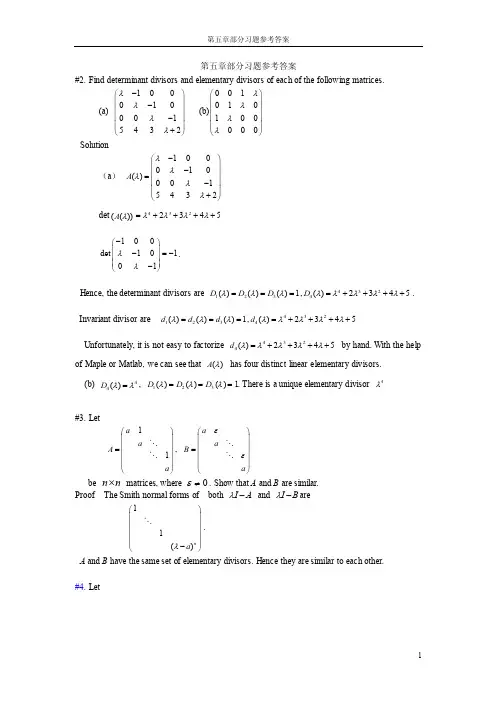
第五章部分习题参考答案#2. Find determinant divisors and elementary divisors of each of the following matrices.(a) 1000100015432λλλλ-⎛⎫ ⎪-⎪ ⎪- ⎪+⎝⎭ (b)001010100000λλλλ⎛⎫⎪ ⎪ ⎪ ⎪⎝⎭Solution(a ) 100010()0015432A λλλλλ-⎛⎫ ⎪- ⎪= ⎪- ⎪+⎝⎭det (())A λ4322345λλλλ=++++100det 10101λλ-⎛⎫⎪-=- ⎪ ⎪-⎝⎭. Hence, the determinant divisors are 123()()()1D D D λλλ===,4324()2345D λλλλλ=++++. Invariant divisor are 123()()()1d d d λλλ===,4324()2345d λλλλλ=++++Unfortunately, it is not easy to factorize 4324()2345d λλλλλ=++++ by hand. With the help of Maple or Matlab, we can see that ()A λ has four distinct linear elementary divisors. (b) 44()D λλ=, 123()()()1D D D λλλ===. There is a unique elementary divisor 4λ #3. Let11a a A a ⎛⎫ ⎪ ⎪= ⎪ ⎪⎝⎭ , a a B a εε⎛⎫ ⎪⎪= ⎪ ⎪⎝⎭ be n n ⨯ matrices, where 0ε≠. Show that A and B are similar.Proof The Smith normal forms of both I A λ- and I B λ-are11()n a λ⎛⎫ ⎪⎪ ⎪ ⎪-⎝⎭. A and B have the same set of elementary divisors. Hence they are similar to each other. #4. Let11a a A a ⎛⎫ ⎪ ⎪= ⎪ ⎪⎝⎭ , 11a a B a ε⎛⎫ ⎪⎪= ⎪ ⎪⎝⎭be n n ⨯ matrices, where 0ε≠. Show that A and B are NOT similar. ProofThe determinant of I A λ- is ()n a λ- . The determinant of I B λ- is ()n a λε--. A and B have distinct characteristic polynomials. Hence, they are not similar.#11. How many possible Jordan forms are there for a 66⨯ complex matrix with characteristic polynomial 42(2)(1)x x +-?Solution The possibilities for the sets of elementary divisors are { 42(2),(1)x x +-}, {4(2),(1),(1)x x x +--}{32(2),(2),(1)x x x ++-}, {3(2),(2),(1),(1)x x x x ++--} {222(2),(2),(1)x x x ++-}, {22(2),(2),(1),(1)x x x x ++--},{22(2),(2),(2),(1)x x x x +++-}, {2(2),(2),(2),(1),(1)x x x x x +++--}{2(2),(2),(2),(2),(1)x x x x x ++++-}, {(2),(2),(2),(2),(1),(1)x x x x x x ++++--}. For each set of elementary divisors, there is a Jordan canonical form up to similarity. There are 10 Jordan canonical forms up to similarity.#12. Classify up to similarity all 33⨯ complex matrices A such that 3A I =. Solution An annihilating polynomial of A is 321(1)()()x x x x ωω-=---, where ω A is diagonalizable.The possibilities for the minimal polynomial of A are1x -, x ω-, 2x ω-;(1x -)(x ω-), (x ω-)(2x ω-), (1x -)(2x ω-);2(1)()()x x x ωω---Up to similarity, all 33⨯ complex matrices A are100010001⎛⎫ ⎪ ⎪ ⎪⎝⎭, 000000ωωω⎛⎫⎪ ⎪ ⎪⎝⎭, 222000000ωωω⎛⎫ ⎪ ⎪ ⎪⎝⎭; 10001000ω⎛⎫⎪ ⎪ ⎪⎝⎭, 1000000ωω⎛⎫ ⎪ ⎪ ⎪⎝⎭; 22000000ωωω⎛⎫ ⎪⎪ ⎪⎝⎭, 2000000ωωω⎛⎫ ⎪ ⎪ ⎪⎝⎭;221000000ωω⎛⎫⎪ ⎪ ⎪⎝⎭,210001000ω⎛⎫⎪ ⎪ ⎪⎝⎭21000000ωω⎛⎫ ⎪ ⎪ ⎪⎝⎭#14. If N is a nilpotent (幂零的) 33⨯ matrix over C , prove that 21128A I N N =+- satisfies2A I N =+, i.e., A is a square root of I N +. Use the binomial series for 1/2(1)t + to obtain asimilar formula for a square root of I N +, where N is any nilpotent n n ⨯ matrix over C .Use the result above to prove that if c is a non-zero complex number and N is a nilpotent complex matrix, then cI N +has a square root. Now use the Jordan form to prove that every non-singular complex n n ⨯ matrix has a square root.Solution If N is an n n ⨯ matrix and k N O =, then k x is an annihilating polynomial for N . The minimal polynomial of N must be of the form p x , where p n ≤ and p k ≤ since the minimal polynomial of a matrix divides its characteristic polynomial. Thus, n N O =.(1) If N is a nilpotent 33⨯ matrix, then 3N O =. By straightforward computation, we can verify that 2A I N =+.(2) If N is an n n ⨯ nilpotent matrix, n N O =.1/22111111(1)(1)((1)1)122222(1)122!(1)!n n t t t t n -----++=+++++- 1/22111111(1)(1)((1)1)122222()22!(1)!n n I N I N N N n -----++=++++-(3) Since1N c is a nilpotent matrix, 1I N c + has a square root 1/21()I N c+. cI N + has a square root 1/21/21()c I N c+.(4) Suppose that 12121()0()000()r d d d r J J P AP J J λλλ-⎛⎫ ⎪⎪==⎪ ⎪ ⎪⎝⎭. Then each ()k d k J λ has asquare root 1/2()k d k J λ since ()k d k J λ is of the form k I N λ+, where 0k λ≠ because A is nonsingular and N is nilpotent.Let 121/211/2211/2()000()000()r d d d r J J B P P J λλλ-⎛⎫⎪⎪=⎪ ⎪⎪⎝⎭, then 2B A =. Hence, A has a squareroot.#20. Prove that the minimal polynomial of a matrix is equal to the characteristic polynomial if andonly if the elementary divisors are relatively prime in pairs.Proof Suppose that a Jordan canonical form of A is1212()000()000()r d d d r J J J J λλλ⎛⎫⎪ ⎪=⎪ ⎪ ⎪⎝⎭(where 12,,,r λλλ are not necessarily distinct. Each ()i d i J λ is a Jordan block.)The minimal polynomial of A is the same as that of J . The characteristic polynomial of A is the same as that of J . The elementary divisors of A are 11()d λλ-, , ()rd r λλ-The minimal polynomial of ()i d i J λ is ()i d i λλ-. The minimal polynomial of J is the least common multiple (最小公倍式) of 11()d λλ-, , ()rd r λλ-. The characteristicpolynomial of J is 1212()()()()rd d d r p λλλλλλλ=--- .The least common divisor of 11()d λλ-, , ()rd r λλ- is equal to the product of11()d λλ-, , ()r d r λλ- if and only if ()j dj λλ-and ()k d k λλ-are relatively prime forj k ≠. Thus the minimal polynomial of a matrix is equal to the characteristic polynomial ifand only if the elementary divisors are relatively prime in pairs.。

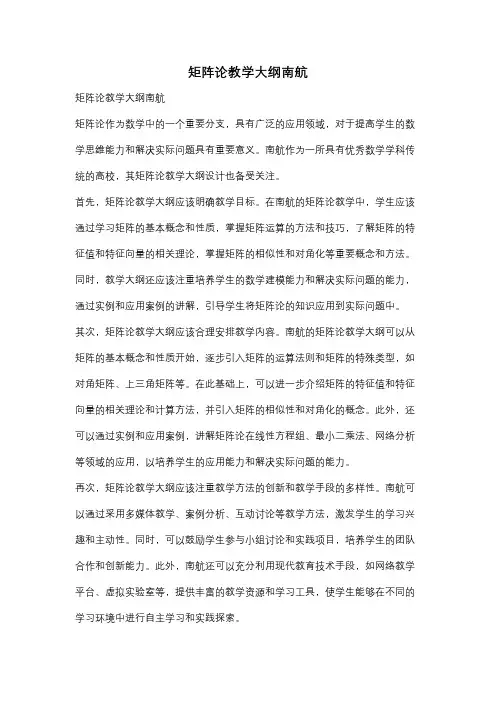
矩阵论教学大纲南航矩阵论教学大纲南航矩阵论作为数学中的一个重要分支,具有广泛的应用领域,对于提高学生的数学思维能力和解决实际问题具有重要意义。
南航作为一所具有优秀数学学科传统的高校,其矩阵论教学大纲设计也备受关注。
首先,矩阵论教学大纲应该明确教学目标。
在南航的矩阵论教学中,学生应该通过学习矩阵的基本概念和性质,掌握矩阵运算的方法和技巧,了解矩阵的特征值和特征向量的相关理论,掌握矩阵的相似性和对角化等重要概念和方法。
同时,教学大纲还应该注重培养学生的数学建模能力和解决实际问题的能力,通过实例和应用案例的讲解,引导学生将矩阵论的知识应用到实际问题中。
其次,矩阵论教学大纲应该合理安排教学内容。
南航的矩阵论教学大纲可以从矩阵的基本概念和性质开始,逐步引入矩阵的运算法则和矩阵的特殊类型,如对角矩阵、上三角矩阵等。
在此基础上,可以进一步介绍矩阵的特征值和特征向量的相关理论和计算方法,并引入矩阵的相似性和对角化的概念。
此外,还可以通过实例和应用案例,讲解矩阵论在线性方程组、最小二乘法、网络分析等领域的应用,以培养学生的应用能力和解决实际问题的能力。
再次,矩阵论教学大纲应该注重教学方法的创新和教学手段的多样性。
南航可以通过采用多媒体教学、案例分析、互动讨论等教学方法,激发学生的学习兴趣和主动性。
同时,可以鼓励学生参与小组讨论和实践项目,培养学生的团队合作和创新能力。
此外,南航还可以充分利用现代教育技术手段,如网络教学平台、虚拟实验室等,提供丰富的教学资源和学习工具,使学生能够在不同的学习环境中进行自主学习和实践探索。
最后,矩阵论教学大纲应该注重评估和反馈机制的建立。
南航可以通过定期的作业、小测验和期末考试等方式,对学生的学习情况进行评估和反馈。
同时,可以建立学生和教师之间的互动平台,及时解答学生的疑问和问题,引导学生进行深入的学习和思考。
此外,南航还可以组织学术交流和学术竞赛等活动,激发学生的学习热情和竞争意识,提高学生的学习效果和能力。
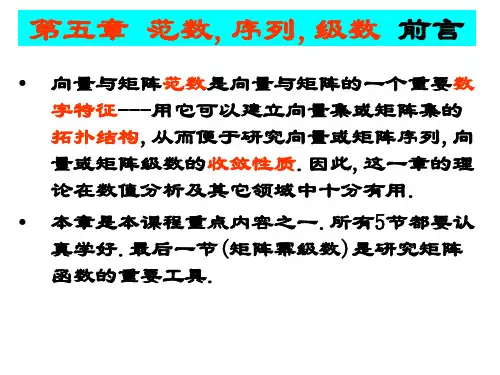
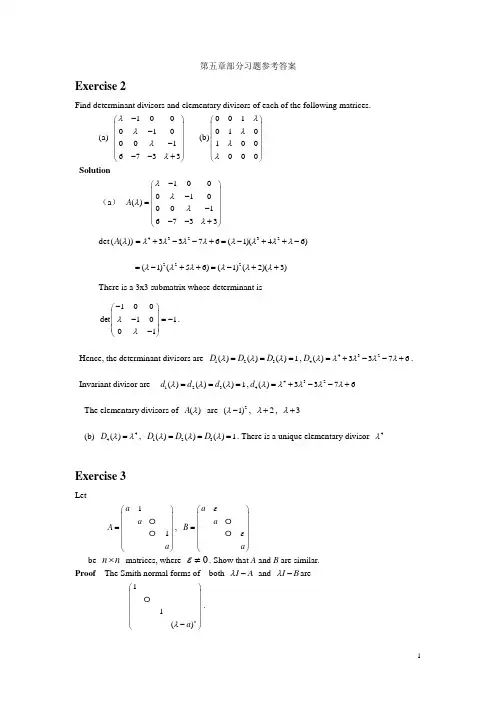
第五章部分习题参考答案Exercise 2Find determinant divisors and elementary divisors of each of the following matrices.(a) 1000100016733λλλλ-⎛⎫ ⎪- ⎪ ⎪- ⎪--+⎝⎭ (b)001010100000λλλλ⎛⎫⎪ ⎪ ⎪ ⎪⎝⎭ Solution(a ) 100010()0016733A λλλλλ-⎛⎫ ⎪-⎪= ⎪- ⎪--+⎝⎭det (())A λ432323376(1)(46)λλλλλλλλ=+--+=-++-222(1)(56)(1)(2)(3)λλλλλλ=-++=-++There is a 3x3 submatrix whose determinant is100det 10101λλ-⎛⎫ ⎪-=- ⎪ ⎪-⎝⎭. Hence, the determinant divisors are 123()()()1D D D λλλ===,4324()3376D λλλλλ=+--+. Invariant divisor are 123()()()1d d d λλλ===,4324()3376d λλλλλ=+--+ The elementary divisors of ()A λ are 2(1)λ-, 2λ+, 3λ+(b) 44()D λλ=, 123()()()1D D D λλλ===. There is a unique elementary divisor 4λExercise 3Let11a a A a ⎛⎫ ⎪ ⎪= ⎪ ⎪⎝⎭ , a a B a εε⎛⎫ ⎪⎪= ⎪ ⎪⎝⎭be n n ⨯ matrices, where 0ε≠. Show that A and B are similar.Proof The Smith normal forms of both I A λ- and I B λ-are11()n a λ⎛⎫ ⎪⎪ ⎪ ⎪-⎝⎭.A andB have the same set of elementary divisors. Hence they are similar to each other.Exercise 4Let11a a A a ⎛⎫ ⎪ ⎪= ⎪ ⎪⎝⎭ , 11a a B a ε⎛⎫ ⎪⎪= ⎪ ⎪⎝⎭be n n ⨯ matrices, where 0ε≠. Show that A and B are NOT similar.ProofThe determinant of I A λ- is ()n a λ- . The determinant of I B λ- is ()n a λε--. A and B have distinct characteristic polynomials. Hence, they are not similar.Exercise 6For each of the following matrices, find the Jordan Canonical Form J and matrix P such that 1P AP J -=(a) 040140122-⎛⎫ ⎪- ⎪ ⎪--⎝⎭(b)134478677-⎛⎫⎪- ⎪ ⎪-⎝⎭Solution(a)40140122I A λλλλ⎛⎫ ⎪-=-+ ⎪ ⎪-+⎝⎭Determinant divisors are 33()det()(2)D I A λλλ=-=+, 2()det()(2)D I A λλλ=-=+,1()1D λ= Invariant divisors are 23()(2)d λλ=+, 2()(2)d λλ=+, 1()1d λ= Elementary divisors are 2(2)λ+, (2)λ+A Jordan canonical form is 210020002-⎛⎫⎪- ⎪ ⎪-⎝⎭. Let123(,,)p p p P =, then1121233222p p p p p p p A A A =-=-=-Solving (2)x 0A I +=, that is, 123240012001200x x x -⎛⎫⎛⎫⎛⎫ ⎪⎪ ⎪-= ⎪⎪ ⎪ ⎪⎪ ⎪-⎝⎭⎝⎭⎝⎭, we obtain that {1p ,3p } form abasis for (2)((0,0,1),(2,1,0))T T N I A Span -= . Let 1(2,1,0)(0,0,1),p T T a b =+ To obtain 2p , we solve the system212(2)p p a A I a b ⎛⎫⎪-== ⎪ ⎪⎝⎭, that is,1232402120120y a y a y b -⎛⎫⎛⎫⎛⎫ ⎪⎪ ⎪-= ⎪⎪ ⎪ ⎪⎪ ⎪-⎝⎭⎝⎭⎝⎭. This system is consistent only if a b =. Let 1a b ==. Then 1(2,1,1)p T =, We solve the system above for vector2(1,0,0)p T =. Take 3(0,0,1)p T =.210100101P ⎛⎫ ⎪= ⎪ ⎪⎝⎭(b) 134478677I A λλλλ--⎛⎫ ⎪-=-+- ⎪ ⎪--⎝⎭23()det()(1)(3)D I A λλλλ=-=+-, 2()1D λ= , 1()1D λ=Invariant divisors are 23()(1)(3)d λλλ=+-, 2()1d λ=, 1()1d λ= Elementary divisors are 2(1)λ+, (3)λ-A Jordan canonical form is 110010003-⎛⎫⎪- ⎪ ⎪⎝⎭. Let123(,,)p p p P =, then11212333p p p p p p p A A A =-=-= 3(1,2,2)p T =, 1(1,2,1)p T =, 2(1,1,0)p T =--111212102P -⎛⎫⎪=- ⎪ ⎪⎝⎭Exercise 8Show that if p A I = for some positive integer p , then A is similar to a diagonal matrix over the complex number field.Proof Since p A I =, 1p x - is an annihilating polynomial. The minimal polynomial ()m x of A must divide 1p x -. Since the polynomial 1p x - has only single roots(单根),()m x has only single roots. Therefore, by Theorem 5.2.7 (see lecture notes p124), matrix A is diagonalizable.Exercise 9Prove that if an n n ⨯ matrix satisfies 256A A I -=then A is diagonalizable.Proof Since 256A A I -=, 256x x -- is an annihilating polynomial of A . . The minimal polynomial ()m x of A must divide 256x x --. Since 256(6)(1)x x x x --=-+, the minimal polynomial must be a product of distinct linear factors. By Theorem 5.2.7 (see lecture notes p124), matrix A is diagonalizable.Exercise 10Show that if A is nonsingular, then 1A - can be written as a polynomial of A .Proof Let 1110()n n n p x c c c λλλ--=++++ be the characteristic polynomial of A . The constant term of ()p x must not be zero since A is nonsingular. By Cayley-Hamilton Theorem,()p A O =. That is, 1110n n n A c A c A c I O --++++= . Thus,1121101()n n n A A c A c I c ----=-+++ , which is a polynomial of A .Exercise 11How many possible Jordan forms are there for a 66⨯ complex matrix with characteristic polynomial 42(2)(1)x x +-?Solution The possibilities for the sets of elementary divisors are { 42(2),(1)x x +-}, {4(2),(1),(1)x x x +--}{32(2),(2),(1)x x x ++-}, {3(2),(2),(1),(1)x x x x ++--} {222(2),(2),(1)x x x ++-}, {22(2),(2),(1),(1)x x x x ++--},{22(2),(2),(2),(1)x x x x +++-}, {2(2),(2),(2),(1),(1)x x x x x +++--}{2(2),(2),(2),(2),(1)x x x x x ++++-}, {(2),(2),(2),(2),(1),(1)x x x x x x ++++--}. For each set of elementary divisors, there is a Jordan canonical form up to similarity. There are 10 Jordan canonical forms up to similarity.Exercise 12Classify up to similarity all 33⨯ complex matrices A such that 3A I =.Solution An annihilating polynomial of A is 321(1)()()x x x x ωω-=---, where ω= A is diagonalizable.The possibilities for the minimal polynomial of A are1x -, x ω-, 2x ω-;(1x -)(x ω-), (x ω-)(2x ω-), (1x -)(2x ω-);2(1)()()x x x ωω---Up to similarity, all 33⨯ complex matrices A are100010001⎛⎫ ⎪ ⎪ ⎪⎝⎭, 000000ωωω⎛⎫⎪ ⎪ ⎪⎝⎭, 222000000ωωω⎛⎫ ⎪ ⎪ ⎪⎝⎭; 10001000ω⎛⎫⎪ ⎪ ⎪⎝⎭, 1000000ωω⎛⎫ ⎪ ⎪ ⎪⎝⎭; 22000000ωωω⎛⎫ ⎪⎪ ⎪⎝⎭, 2000000ωωω⎛⎫ ⎪ ⎪ ⎪⎝⎭;221000000ωω⎛⎫⎪ ⎪ ⎪⎝⎭,210001000ω⎛⎫⎪ ⎪ ⎪⎝⎭21000000ωω⎛⎫ ⎪ ⎪ ⎪⎝⎭Exercise 14If N is a nilpotent (幂零的) 33⨯ matrix over C , prove that 21128A I N N =+- satisfies2A I N =+, i.e., A is a square root of I N +. Use the binomial series for 1/2(1)t + to obtain asimilar formula for a square root of I N +, where N is any nilpotent n n ⨯ matrix over C .Use the result above to prove that if c is a non-zero complex number and N is a nilpotent complex matrix, then cI N +has a square root. Now use the Jordan form to prove that every non-singular complex n n ⨯ matrix has a square root.Solution If N is an n n ⨯ matrix and k N O =, then k x is an annihilating polynomial for N . The minimal polynomial of N must be of the form p x , where p n ≤ and p k ≤ since the minimal polynomial of a matrix divides its characteristic polynomial. Thus, n N O =.(1) If N is a nilpotent 33⨯ matrix, then 3N O =. By straightforward computation, we canverify that 2A I N =+.(2) If N is an n n ⨯ nilpotent matrix, n N O =.1/22111111(1)(1)((1)1)122222(1)122!(1)!n n t t t t n -----++=+++++- 1/22111111(1)(1)((1)1)122222()22!(1)!n n I N I N N N n -----++=++++-(3) Since1N c is a nilpotent matrix, 1I N c + has a square root 1/21()I N c+. cI N + has a square root 1/21/21()c I N c+.(4) Suppose that 12121()00()000()r d d d r J J P AP J J λλλ-⎛⎫ ⎪⎪==⎪ ⎪ ⎪⎝⎭. Then each ()k d k J λ has asquare root 1/2()k d k J λ since ()kd k J λ is of the form k I N λ+, where 0k λ≠ because A is nonsingular and N is nilpotent.Let 121/211/2211/2()000()000()r d d d r J J B P P J λλλ-⎛⎫⎪⎪=⎪ ⎪⎪⎝⎭, then 2B A =. Hence, A has a squareroot.Exercise 20Prove that the minimal polynomial of a matrix is equal to the characteristic polynomial if andonly if the elementary divisors are relatively prime in pairs.Proof Suppose that a Jordan canonical form of A is1212()000()000()r d d d r J J J J λλλ⎛⎫ ⎪⎪= ⎪ ⎪⎪⎝⎭(where 12,,,r λλλ are not necessarily distinct. Each ()id i J λ is a Jordan block.)The minimal polynomial of A is the same as that of J . The characteristic polynomial of A is the same as that of J . The elementary divisors of A are 11()d λλ-, , ()rd r λλ-The minimal polynomial of ()id i J λ is ()id i λλ-. The minimal polynomial of J is theleast common multiple (最小公倍式) of 11()d λλ-, , ()rd r λλ-. The characteristicpolynomial of J is 1212()()()()rd d d r p λλλλλλλ=--- .The least common divisor of 11()d λλ-, , ()rd r λλ- is equal to the product of11()d λλ-, , ()r d r λλ- if and only if ()j dj λλ-and ()k d k λλ-are relatively prime for j k ≠. Thus the minimal polynomial of a matrix is equal to the characteristic polynomial ifand only if the elementary divisors are relatively prime in pairs.。
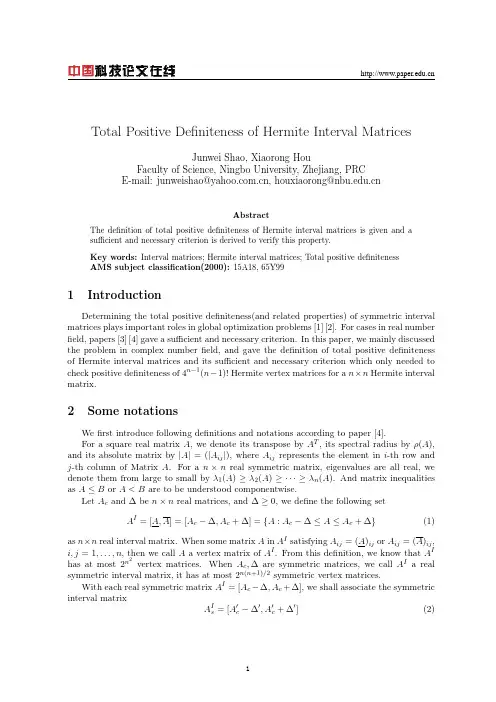
Total Positive Definiteness of Hermite Interval MatricesJunwei Shao,Xiaorong HouFaculty of Science,Ningbo University,Zhejiang,PRCE-mail:junweishao@,houxiaorong@AbstractThe definition of total positive definiteness of Hermite interval matrices is given and asufficient and necessary criterion is derived to verify this property.Key words:Interval matrices;Hermite interval matrices;Total positive definitenessAMS subject classification(2000):15A18,65Y991IntroductionDetermining the total positive definiteness(and related properties)of symmetric interval matrices plays important roles in global optimization problems[1][2].For cases in real number field,papers[3][4]gave a sufficient and necessary criterion.In this paper,we mainly discussed the problem in complex numberfield,and gave the definition of total positive definiteness of Hermite interval matrices and its sufficient and necessary criterion which only needed to check positive definiteness of4n−1(n−1)!Hermite vertex matrices for a n×n Hermite interval matrix.2Some notationsWefirst introduce following definitions and notations according to paper[4].For a square real matrix A,we denote its transpose by A T,its spectral radius byρ(A), and its absolute matrix by|A|=(|A ij|),where A ij represents the element in i-th row and j-th column of Matrix A.For a n×n real symmetric matrix,eigenvalues are all real,we denote them from large to small byλ1(A)≥λ2(A)≥···≥λn(A).And matrix inequalities as A≤B or A<B are to be understood componentwise.Let A c and∆be n×n real matrices,and∆≥0,we define the following setA I=[A,A]=[A c−∆,A c+∆]={A:A c−∆≤A≤A c+∆}(1) as n×n real interval matrix.When some matrix A in A I satisfying A ij=(A)ij or A ij=(A)ij, i,j=1,...,n,then we call A a vertex matrix of A I.From this definition,we know that A I has at most2n2vertex matrices.When A c,∆are symmetric matrices,we call A I a real symmetric interval matrix,it has at most2n(n+1)/2symmetric vertex matrices.With each real symmetric matrix A I=[A c−∆,A c+∆],we shall associate the symmetric interval matrixA I s=[A c−∆ ,A c+∆ ](2)whereA c=12A c+A T c,∆ =12∆+∆here we know,if A∈A I,then12A+A T∈A I s.Now we introduce following setY={z:z∈R n,|z j|=1,j=1,...n},its cardinal number is2n.For each z∈Y,we define T z as the n×n diagonal matrix whose diagonal vector is z,and letA z=A c−T z∆T z(3)Then,for each pair i,j,we have(A z)ij=(A c−∆)ij if z i z j=1;and(A z)ij=(A c+∆)ij if z i z j=−1.So A z∈A I,in fact,A z is a vertex matrix of A I.Since A−z=A z,{A z|z∈Y} have at most2n−1different matrices(exactly2n−1when∆>0).When A I is symmetric,A z is also symmetric.Now we define function f:R n×n→R1f(A)=minx=0x T Axx T x(4)When f(A)≥0,we say that A is positive semidefinite(that is,for each x,x T Ax≥0, this definition conforms to the usual one).Similarly,when f(A)>0,we say that A is positive definite(that is,for each x=0,x T Ax>0).Real interval matrix A I is total positive (simi)definite if every A∈A I is positive(simi)definite.For the total positive(semi)definiteness of real interval matrices,we have the following elegant theorem.Theorem1.[4]Let A I be a interval matrix,then the following assertions are equivalent: (i)A I is total positive(semi)definite;(ii)A I s is total positive(semi)definite;(iii)A z is total positive(semi)definite for each z∈Y.From theorem1,it only needs to check positive(semi)definiteness of2n−1vertex matrices to determine the positive(semi)definiteness of a interval matrix.This result in paper[4]is an improvement on the one in paper[3],in the latter,it needs to check positive(semi)definiteness of2n(n−1)/2vertex matrices.Further,in paper[5],it was proved that the problem of deter-mining the total positive definiteness of a symmetric interval matrix is HP-hard.Now we consider interval matrices in complex numberfield and corresponding results.3Main resultsFirst we introduce corresponding definitions in the complex numberfield.For an n×n complex matrix C=(c rs),we denote its Hermite transpose by C H,when C=C H,we call C a Hermite matrix,it is well known that its eigenvalues are all real numbers, we denote them from large to small byλ1(C)≥λ2(C)≥...≥λn(C).Let A I,B I be n×n real interval matrices,whereA I=[A,A],B I=[B,B].We define an n×n complex interval matrix asC I=A I+iB I={A+Bi:A∈A I,B∈B I}(5)When A,B are vertex matrices of A I,B I respectively,we call A+Bi a vertex matrix of C I.It can be seen that C I has2n2×2n2=22n2vertex matrices.When A I,B I are real symmetric interval matrices,and B=−B,we can define the following n×n Hermite interval matrix:C I H={A+Bi:A∈A I,B∈B I,A is symmetric,B is antisymmetric}(6) It has at most2n(n+1)/2×2n(n−1)/2=2n2Hermite vertex matrices.Now we define the function g:C IH→R1asg(C)=minx=0x H Cxx H x(7)In fact,g(C)=λn(C).When g(C)≥0,we say that C is positive semidefinite(that is,foreach x,x H Cx≥0,this confirms the usual definition),similarly,when g(C)>0,we say that C is positive definite(that is,for each x=0,we have x H Cx>0).A Hermite interval matrix is total positive(semi)definite if each C∈C IHis positive(semi)definite.Theorem2.The minimum eigenvalues of Hermite matrices in an n×n Hermite intervalmatrix C IHobtain the minimal value at some Hermite vertex matrix.Proof.Suppose A+Bi is some Hermite matrix in C IH ,and X+Y i=(x1+y1i,x2+y2i,...,x n+y n i)T is the eigenvector which has modular1correspond to the smallest eigenvalueλn(A+Bi). Let U be the n-dimension all-1column vector,thenλn(A+Bi)=(X+Y i)H(A+Bi)(X+Y i)=U T((A+Bi)◦((X+Y i)(X+Y i)H))U(8)Where A◦B represents the Hardmard production of matrices A and B,that is,the matrix of productions of correspond elements of A and B.Next,we construct a matrix Q=(u rs+iv rs)n×n as follows:u rs=A rs,x r x s+y r y s≥0A rs,x r x s+y r y s<0v rs=B rs,x r y s−x s y r≥0B rs,x r y s−x s y r<0From the definition,we know that Q is a Hermite matrix and satisfies:u rr=A rr,v rr=B rr,u rs(x r x s+y r y s)≤A rs(x r x s+y r y s),v rs(x r y s−x x y r)≤B rs(x r y s−x x y r).therefore((u rs+iv rs)(x r+iy r)(x s−iy s))=u rs(x r x s+y r y s)+v rs(x r y s−x s y r)≤A rs(x r x s+y r y s)+B rs(x r y s−x s y r)= ((A rs+iB rs)(x r+iy r)(x s−iy s)),where (x)represents the real part of number x.Thus such Q we constructed satisfies (Q◦((X+Y i)(X+Y i)H))≤ ((A+Bi)◦((X+Y i)(X+Y i)H)),where (W n×n)=( (W ij))n×n.Note thatλn(A+Bi)=min{Z H(A+Bi)Z: Z =1,Z∈C n},thus we haveλn(Q)=min{Z H QZ: Z =1,Z∈C n}≤(X+Y i)H Q(X+Y i)=U T(Q◦((X+Y i)(X+Y i)H))U=U T (Q◦((X+Y i)(X+Y i)H))U≤U T ((A+Bi)◦((X+Y i)(X+Y i)H))U=U T((A+Bi)◦((X+Y i)(X+Y i)H))U=(X+Y i)H(A+Bi)(X+Y i)=λn(A+Bi)(9)Since A+Bi is an arbitrary Hermite matrix in C IH ,it follows that the minimum of minimaleigenvalues of Hermite matrices in C IH is obtained at some vertex Hermitematrix.Since g(C)=λn(C),we haveCorollary1.n×n Hermite interval matrix C IHis total positive(semi)definite if and only if its2n2Hermite vertex matrices are positive(semi)definite.In fact,the number of vertex matrices can be reduced to4n−1(n−1)!in Theorem2and its corollary.To prove it,we need the following auxiliary statement.First we define the sign of matrix A=(a ij)as sign(A)=(sign(a ij))and we set sign0=1.Lemma.The cardinal number of the setS n={(sign(XX T+Y Y T),sign(XY T−Y X T)):X,Y∈R n}is at most4n−1(n−1)!.Proof.We use induction on n.For n=1,S1={(sign(x21+y21),sign0)}={(1,1)},its cardinal number is1.Now suppose that the statement required is proved for S n−1.Letαi,j=(XX T+Y Y T)ij=x i x j+y i y jβi,j=(XY T−Y X T)ij=x i y j−x j y ithen we haveαj,k(x2i+y2i)=(αi,jαi,k+βi,jβi,k)βj,k(x2i+y2i)=(αi,jβi,k−αi,kβi,j)αi,j=αj,iβi,j=−βj,iαi,i≥0βi,i=0so it suffices to prove that the number of different combinations of signs of(α1,n,β1,n,α2,n,β2,n,...,αn−1,n,βn−1,n)is4(n−1).We can assume that x2i+y2i=0for each i,otherwise,the elements in i-th row and i-th column are all zeros,which can be reduced to the case corresponds to S n−1.Thereforeαj,n=αi,jαi,n+βi,jβi,nx2i+y2iβj,n=αi,jβi,n−αi,nβi,jx2i+y2i(10)Further,we havesign(αj,n)=sign(αi,jαi,n),ifαi,jβi,jαi,nβi,n≥0sign(βj,n)=sign(αi,jβi,n),ifαi,jβi,jαi,nβi,n<0(11)Fix the signs ofα1,n andβ1,n,then it suffices to prove that the number of different combinations of signs of(α2,n,β2,n,...,αn−1,n,βn−1,n)is n−1.Indeed,the number of different combinations of signs of(α1,n,β1,n)is equal to4,it therefore deduces the statement required.From(11),we know that,when wefixα1,n andβ1,n,signs ofµ2,µ3,...,µn−1are deter-mined,whereµj=αj,n orβj,n,and we denote the other number in{αj,n,βj,n}exceptµj by ˜µj.Now we choose a sign of˜µ2,again,signs ofµ2,˜µ2determine signs of someµj,˜µj,without loss of generality,we assume that they determine signs ofµ3,...,µk+2,˜µk+3,...,˜µn−1.Wefirst proved that,ifα2,n,β2,n determine a sign of the same numberµj asα1,n,β1,n do, then they determine a same sign ofµj,that is,ifsign(α1,jβ1,jα1,nβ1,n)=sign(α2,jβ2,jα2,nβ2,n)(12) thensign(α1,jα1,n)=sign(α2,jα2,n)or sign(α1,jβ1,n)=sign(α2,jβ2,n)(13) Indeed,wefirst assume thatα1,jβ1,jα1,nβ1,n≥0.Ifα1,2β1,2α1,nβ1,n≥0,thenα1,2β1,2α1,jβ1,j≥0,sosign(α2,n)=sign(α1,2α1,n),sign(α2,j)=sign(α1,2α1,j).Thereforesign(α2,jα2,n)=sign(α1,2α1,jα1,2α1,n)=sign(α1,jα1,n).While ifα1,2β1,2α1,nβ1,n<0,thenα1,2β1,2α1,jβ1,j<0,sosign(β2,n)=sign(α1,2β1,n),sign(β2,j)=sign(α1,2β1,j).Thereforesign(β2,jβ2,n)=sign(α1,2β1,jα1,2β1,n)=sign(β1,jβ1,n).with the assumptionsign(α1,jβ1,jα1,nβ1,n)=sign(α2,jβ2,jα2,nβ2,n)=1,we can deduce thatsign(α1,jα1,n)=sign(α2,jα2,n).Similarly,ifα1,jβ1,jα1,nβ1,n<0,we can prove thatsign(α1,jβ1,n)=sign(α2,jβ2,n).We now use induction to prove that whenµ2,˜µ2determine signs of the same k numbers asα1,n,β1,n do,then number of different combinations of signs of(α3,n,β3,n,...,αn−1,n,βn−1,n)after we chooseα1,n,β1,n,α2,n,β2,nis equal to k+1.When k equals1,the statement is obviously true,in the following,we suppose it has been proved for cases correspond numbers less then k.Now we choose˜µ3,thenµ3,˜µ3determine signs of p numbers in{µ4,...,µk+2},and k−1−p numbers in{˜µ4,...,˜µk+2}.From the induction hypothesis,we know this˜µ3corresponds p+1different combinations of signs of(α4,n,β4,n,...,αn−1,n,βn−1,n),while when we choose the opposite sign for˜µ3with the former one we choose,µ3,˜µ3determine signs of k−1−p numbers in{µ4,...,µk+2},and p numbers in{˜µ4,...,˜µk+2},this˜µ3 corresponds k−1−p+1=k−p different combinations of signs of(α4,n,β4,n,...,αn−1,n,βn−1,n).So the total number of different combinations of signs of(α3,n,β3,n,...,αn−1,n,βn−1,n)is equal to(p+1)+(k−p)=k+1,this is what we require.Now return to the proof of the lemma,sinceµ2,˜µ2determine signs ofµ3,...,µk+2,˜µk+3,...,˜µn−1,this µ2,˜µ2corresponds k +1different combinations of signs of them,while when we choose ˜µ2with opposite sign,then µ2,˜µ2determine signs of˜µ3,...,˜µk +2,µk +3,...,µn −1,this µ2,˜µ2corresponds n −k −3+1=n −k −2different combinations of signs of them,so the total number of different combinations of signs of(α2,n ,β2,n ,...,αn −1,n ,βn −1,n )is equal to (k +1)+(n −k −2)=n −1,as was required.Now we define a set V n for the Hermite interval matrix C I H=A I +iB I :Q =(u rs +iv rs )∈V n ⇔(M,N )∈S n ,and u rs = A rs ,M rs =1A rs ,M rs =−1,v rs = B rs ,N rs =1B rs ,N rs =−1(14)then from the proof of theorem 2,we can reduce the number of Hermite vertex matrices we used in it and its corollary.Theorem 2 .The minimum eigenvalues of Hermite matrices in a n ×n Hermite intervalmatrix C I H obtain the minimal value at a Hermite vertex matrix in V n corresponding to C I H.Corollary 1 .n ×n Hermite interval matrix C I H is total positive (semi)definite if and only if all Hermite vertex matrices in V n corresponding to C I Hare positive (semi)definite.References[1]Adjiman C S,Dallwig S,Floudas C A,et al.A Global Optimization Method,αBB,forGeneral Twice-differentiable Constrained NLPs–i.Theoretical Advances [J].Computers Chem.Engng,1998,Vol.22:1137-1158.[2]Adjiman C S,Androulakis I P,Floudas C A.A Global Optimization Method,αBB,forGeneral Twice-differentiable Constrained NLPs–ii.Implementation and Computational Results [J].Computers Chem.Engng,1998,Vol.22:1159-1179.[3]ShiZhicheng,GaoWeibin.A Necessary and Sufficient Condition for the Positive-definiteness of Interval Symmetric Matrices [J].Internat.J.Control.1986,Vol.43:325-328.[4]Rohn Jiri.Positive Definiteness and Stability of Interval Matrices [J].SIAM J.MatrixAnal.Appl.1994,Vol.15,No.1:175-184.[5]Rohn Jiri.Checking positive definiteness or stability of symmetric interval matrices isNP-hard [J].Comment.Math.Univ.Carolinae.1994,Vol.35,No.4:795-797。
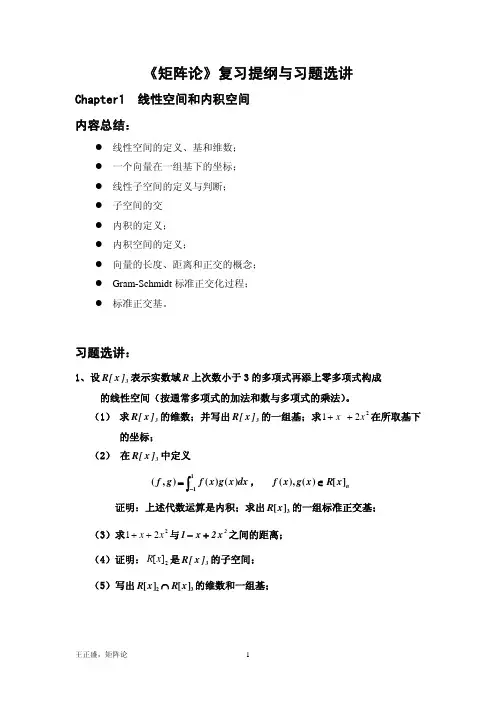
《矩阵论》复习提纲与习题选讲Chapter1 线性空间和内积空间内容总结:z 线性空间的定义、基和维数;z 一个向量在一组基下的坐标;z 线性子空间的定义与判断;z 子空间的交z 内积的定义;z 内积空间的定义;z 向量的长度、距离和正交的概念;z Gram-Schmidt 标准正交化过程;z 标准正交基。
习题选讲:1、设表示实数域3]x [R R 上次数小于3的多项式再添上零多项式构成 的线性空间(按通常多项式的加法和数与多项式的乘法)。
(1) 求的维数;并写出的一组基;求在所取基下的坐标;3]x [R 3]x [R 221x x ++ (2) 在中定义3]x [R , ∫−=11)()(),(dx x g x f g f n x R x g x f ][)(),(∈ 证明:上述代数运算是内积;求出的一组标准正交基;3][x R (3)求与之间的距离;221x x ++2x 2x 1+−(4)证明:是的子空间;2][x R 3]x [R (5)写出2[][]3R x R x ∩的维数和一组基;二、 设22R ×是实数域R 上全体22×实矩阵构成的线性空间(按通常矩阵的加 法和数与矩阵的乘法)。
(1) 求22R ×的维数,并写出其一组基;(2) 在(1)所取基下的坐标; ⎥⎦⎤⎢⎣⎡−−3111(3) 设W 是实数域R 上全体22×实对称矩阵构成的线性空间(按通常矩阵的加法和数与矩阵的乘法)。
证明:W 是22R ×的子空间;并写出W 的维数和一组基;(4) 在W 中定义内积, )A B (tr )B ,A (T =W B ,A ∈求出W 的一组标准正交基;(5)求与之间的距离; ⎥⎦⎤⎢⎣⎡0331⎥⎦⎤⎢⎣⎡−1221 (6)设V 是实数域R 上全体22×实上三角矩阵构成的线性空间(按通常矩阵的加法和数与矩阵的乘法)。
证明:V 也是22R ×的子空间;并写出V 的维数和一组基;(7)写出子空间的一组基和维数。
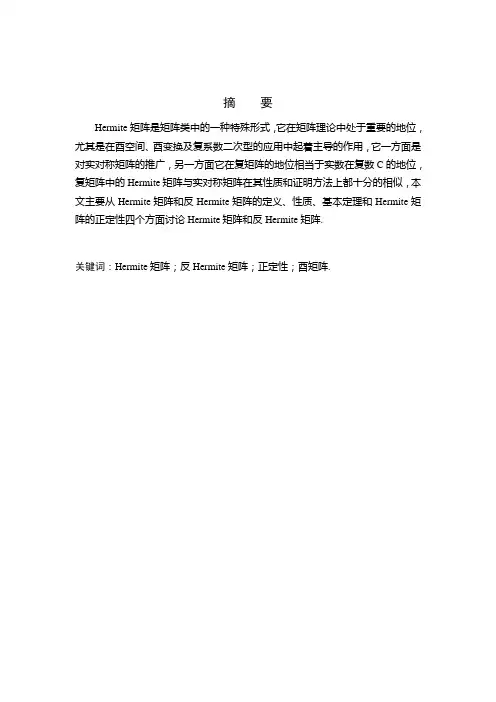
摘要Hermite矩阵是矩阵类中的一种特殊形式,它在矩阵理论中处于重要的地位,尤其是在酉空间、酉变换及复系数二次型的应用中起着主导的作用,它一方面是对实对称矩阵的推广,另一方面它在复矩阵的地位相当于实数在复数C的地位,复矩阵中的Hermite矩阵与实对称矩阵在其性质和证明方法上都十分的相似,本文主要从Hermite矩阵和反Hermite矩阵的定义、性质、基本定理和Hermite矩阵的正定性四个方面讨论Hermite矩阵和反Hermite矩阵.关键词:Hermite矩阵;反Hermite矩阵;正定性;酉矩阵.AbstractThe Hermite matrix forms a special class of matrices in matrix theory.It occupies an important position in the matrix theory and plays a leading role,especially in the unitary space,unitary transformation and the application of the quadratic form of coefficient of polytropy.On the one hand,it is the promotion of the real symmetric matrix ,on the other hand,the staues it occupies in the complex matrix comes up to the position that real number in the plural form C. In the nature and methods of proof ,Hermite matrices and real symmetric matrix are very similar. This article is concerned about the definition,nature,fundamental theorem of the Hemite matrix and anti-Hermite matrix and the positive definiteness of Hermite matrix.Key words:Hermite matrix;Anti-Hermite matrix;Positive definite;Unitary matrix目录一、引言 (01)二、Hermite矩阵和反Hermite矩阵的定义 (01)三、Hermite矩阵的性质定理(一)Hermite矩阵的性质 (02)(二)Hermite矩阵的定理 (02)(三)Hermite矩阵的正定性 (05)四、反Hermite矩阵的性质定理(一)反Hermite矩阵的性质 (14)(二)反Hermite矩阵的定理 (15)五、结论 (20)参考文献 (21)致谢 (22)Hermite 矩阵与反Hermite 矩阵一、引言众所周知,矩阵理论在历史上至少可追溯到Sylvester 与Cayley ,特别是Cayley 1858年的工作.近代数学的一些学科,如代数结构理论与泛函分析可以在矩阵理论中寻到它们的根源,另一方面,随着计算机的广泛应用,矩阵理论在不断地发展,矩阵已成为处理数值问题的有力工具.作为数学的一个重要分支,矩阵理论具有极为丰富的内容,在数学以及其他科学技术领域都有十分重要的应用,如数值分析、最优化理论、运筹学与控制论、概率论与数理统计、力学、电学、信息科学、管理科学与工程技术等都与矩阵理论有着密切的关系.对称矩阵是一类非常重要的矩阵,近年来,在矩阵理论中,Hermite 矩阵的应用越来越广泛,对其研究也取得很大的进展.在复矩阵中,Hermite 矩阵实际上是实对称矩阵的推广,它在复矩阵中的地位相当于实数在复数中的地位,本文主要从Hermite 矩阵和反Hermite 矩阵的定义、性质,基本定理以及Hermite 矩阵正定性几个方面讨论Hermite 矩阵和反Hermite 矩阵并给出了相关的证明,来加深对矩阵理论的理解,从而能更好地使用这些工具.二、Hermite 矩阵和反Hermite 矩阵的定义定义 1 设A 是一个n 阶复矩阵,即n n A C ´Î,H A 为A 的共轭转置,H A =A , 则将称A 为Hermite 矩阵.若H A A =-,则称之为反Hermite 矩阵. 定义 2 设A 是一个n 阶Hermite 矩阵,若对于任一非零的n 维复向量X ,均有0H X AX >,则称A 为Hermite 正定矩阵.定义 3 设A 是一个n 阶复矩阵,H A 为A 的共轭转置,若H H AA A A =,则称A 为正规矩阵.定义 4 设A 是一个n 阶复矩阵,H A 为A 的共轭转置,H H A A AA E ==,则将称A 为酉矩阵,它的行列式的绝对值等于1.三、Hermite 矩阵的性质定理(一)Hermite 矩阵的性质由Hermite 矩阵的定义可知,Hermite 矩阵具有如下简单的性质[][]12:(1)对所有n n A C ´Î,则H A A +,H AA 和H A A 都是Hermite 矩阵;(2)如果A 是Hermite 矩阵,则对正整数k ,k A 也是Hermite 矩阵;(3)如果A 是可逆Hermite 矩阵,则1A -也是Hermite 矩阵;(4)如果A ,B 是Hermite 矩阵,则对实数k ,p ,kA pB +也是Hermite 矩阵;(5)如果A ,B 是Hermite 矩阵,则AB 是Hermite 矩阵的充分必要条件是AB BA =;(6)A 是Hermite 矩阵的充分必要条件是对于任意n 阶方阵S ,H S AS 是Hermite 矩阵.(二)Hermite 矩阵的定理定理3-1 若A 是n 阶复矩阵,则A 是Hermite 矩阵的充分必要条件是对于任意n X C Î,H X AX 是实数;证明 必要性 因为H X AX 是数,所以()H X AX =()H H X AX =H H X A X =H X AX因此H X AX 是实数.充分性 因为对于任意X ,Y n C Î,H X AX ,H Y AY ,()()H X Y A X Y ++都是实数,而()()()()H H H H H H H X Y A X Y X Y A X Y X AX X AY Y AX Y AY ++=++=+++ 于是对任意X ,Y n C Î,H H X AY Y AX +是实数,令(,,,,,,)T j X =00100,(,,,,,,)T k Y =00100则H H X AY Y AX +=jk kj a a +是实数,这表明jk a 与kj a 的虚部值相等,但符号相反,即()()jk kj Im a Im a =-再令(,,,,,,)T j X i =0000,(,,,,,,)T k Y =00100其中i =H H X AY Y AX +=jk kj ia ia -+是实数,则jk a 与kj a 的实部相等,即()()jk kj Re a Re a =因此kj jk a a =,,,,,,j k n =123即A 是Hermite 矩阵. 定理3-2[]4(Hermite 矩阵的谱定理) 设n n A C ´Î是给定的,则A 是Hermite 矩阵当且仅当存在一个酉矩阵n n U C ´Î和一个实对角矩阵n n C ´L ?,使得H U AU =L 12(,,,)n diag l l l =,其中12,,,n l l l 均为实数,此外,A 是实Hermite 矩阵(即实对称的),当且仅当存在一个实正交矩阵n n P C ´Î和一个实对角矩阵n n C ´L ?,使得12(,,,)H n P AP diag l l l =L =,其中12,,,n l l l 均为实数.虽然Hermite 矩阵的实线性组合总是Hermite 矩阵,但它们的复线性组合就不一定是Hermite 矩阵,例如,如果A 是Hermite 矩阵,那么,只有当0A =时iA 才是Hermite 矩阵.另外,如果A 和B 是Hermite 矩阵,那()H H H AB B A BA ==,因此,AB 是Hermite 矩阵,当且仅当A 与B 可交换.定理3-3 设A 为n 阶Hermite 矩阵,则(ⅰ)A 是正规矩阵且所有特征值全是实数;(ⅱ)A 的不同特征值所对应的特征向量是互相正交的.证明 (ⅰ)A 为n 阶Hermite 矩阵,由定理3-2可知A 必酉相似于实对角矩阵L ,即存在n 阶酉矩阵U ,使得H U AU =L其中L =12(,,,)n diag l l l ,(,,,)i i n l =12是A 的是特征值,且2H H A A A AA ==即A 是正规矩阵.设H A A =,l 为A 的特征值,非零向量a 为l 的特征向量,即A a l a =,H H A a a l a a =又()()H H H H A A A a a a a a a l a a ===所以H H l a a l a a =即 l l =所以l 为实数.(ⅱ)设l ,m 是A 的两个不同特征值,相应的特征向量分别为x ,y ,则Ax x l =,Ay y m =从而H H y Ax y x l =,H H x Ay x y m =因为A 是Hermite 矩阵,l ,m 均为实数,则H H y Ax y x m =于是()0H y x l m -=由于l m ¹,故x 与y 正交.定理3-4[]5(Hermite 矩阵的惯性定理) 设H 是n 阶Hermite 矩阵,则H (复)合同与0p q I A I 骣÷ç÷ç÷ç÷ç÷ç÷ç÷ç÷桫=-, 而且p ,q 由H 唯一确定.其中A 称为H 的规范型,n I 表示n 阶单位矩阵,p ,q ,p q -分别称为H 的正惯性指数、负惯性指数和符号差.注:由惯性定理导出的Hermite 矩阵的正惯性指数、负惯性指数及符号差等,不仅是代数学中的重要内容,而且在几何学、物理学中都有许多重要的应用,构成几何对象及物理对象的“指标”或“守恒量” .下面讨论一下Hermite 矩阵的正定性.(三)Hermite 矩阵的正定性在讨论Hermite 矩阵的正定性之前,我们先来引入矩阵的UR 分解定理及其引理.矩阵UR 分解定理 设n n n A C ´Î,则A 可以唯一地分解为A UR =或11A RU =其中U ,1U n n U ´Î,R 是正线上三角阵,1R 是正线下三角阵。
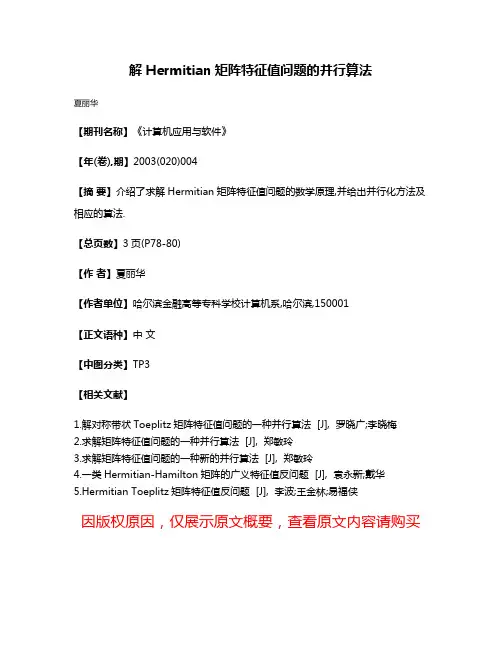
解Hermitian矩阵特征值问题的并行算法
夏丽华
【期刊名称】《计算机应用与软件》
【年(卷),期】2003(020)004
【摘要】介绍了求解Hermitian矩阵特征值问题的数学原理,并给出并行化方法及相应的算法.
【总页数】3页(P78-80)
【作者】夏丽华
【作者单位】哈尔滨金融高等专科学校计算机系,哈尔滨,150001
【正文语种】中文
【中图分类】TP3
【相关文献】
1.解对称带状Toeplitz矩阵特征值问题的一种并行算法 [J], 罗晓广;李晓梅
2.求解矩阵特征值问题的一种并行算法 [J], 郑敏玲
3.求解矩阵特征值问题的一种新的并行算法 [J], 郑敏玲
4.一类Hermitian-Hamilton矩阵的广义特征值反问题 [J], 袁永新;戴华
5.Hermitian Toeplitz矩阵特征值反问题 [J], 李波;王金林;易福侠
因版权原因,仅展示原文概要,查看原文内容请购买。

一个关于半正定Hermite矩阵特征值的不等式
黄弘
【期刊名称】《湖北工程学院学报》
【年(卷),期】2006(026)006
【摘要】将控制不等式理论与复合矩阵结合起来,得到一个半正定Hermite矩阵特征值的不等式.
【总页数】3页(P57-58,61)
【作者】黄弘
【作者单位】孝感学院,数学系,湖北,孝感,432000
【正文语种】中文
【中图分类】O151.21
【相关文献】
1.半正定Hermite矩阵之积的特征值估计 [J], 黄弘
2.半正定Hermite矩阵的一个不等式 [J], 王琳;朱永娥
3.关于半正定Hermite矩阵的一个不等式 [J], 李宏年
4.半正定Hermite矩阵乘积的特征值估计 [J], 杨一新
5.半正定Hermite矩阵的不等式的证明 [J], 赵林
因版权原因,仅展示原文概要,查看原文内容请购买。
关于Hermite矩阵正定性判定的等价条件及证明
张厚超;李瑞娟
【期刊名称】《河南教育学院学报(自然科学版)》
【年(卷),期】2009(018)001
【摘要】给出了Hermite矩阵正定性判定的若干等价条件,并对这些条件进行优化排序,然后给出简洁证明.
【总页数】2页(P7-8)
【作者】张厚超;李瑞娟
【作者单位】平顶山学院数学与信息科学学院,河南平顶山467000;平顶山学院数学与信息科学学院,河南平顶山467000
【正文语种】中文
【中图分类】O151.21
【相关文献】
1.实二次型正定性的一个判定定理的又一种证明 [J], 黄益生
2.实二次型正定性的一个判定定理的另一种证明 [J], 黄益生;郑玉莲
3.有理数域上二元多项式正半定性的判定 [J], 梁松新;李传中
4.带约束分数阶正系统稳定性与镇定的判定和计算的一个新方法 [J], 司新栋;杨洪礼
5.应用H矩阵判定矩阵的正稳定性(为庆贺游兆永教授60寿辰而作) [J], 永学荣因版权原因,仅展示原文概要,查看原文内容请购买。